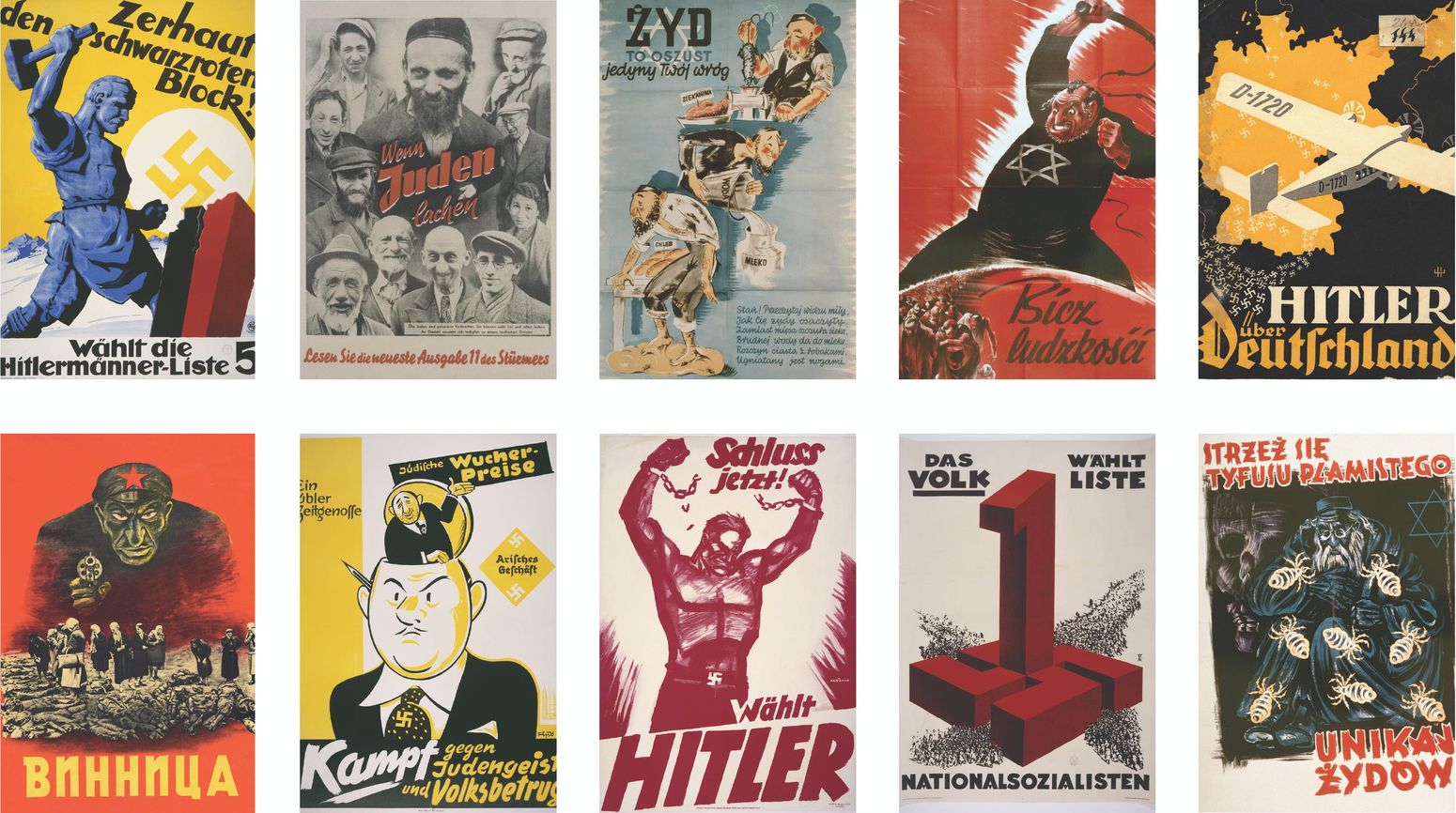
Nazi propaganda posters played a crucial role in spreading the ideology of the Third Reich. These posters were designed to influence public opinion, instill national pride, and promote anti-Semitic beliefs. Why were these posters so effective? They combined striking visuals with powerful messages, making them hard to ignore. The use of bold colors, dramatic imagery, and emotional appeals ensured that the messages resonated deeply with the German populace. What can we learn from these historical artifacts? Understanding the techniques used in Nazi propaganda can help us recognize and combat similar tactics in today's media landscape. Let's delve into 35 intriguing facts about these powerful tools of persuasion.
Key Takeaways:
- Nazi propaganda posters were powerful tools used to influence public opinion and spread the ideology of the Third Reich, shaping perceptions and promoting hatred through emotional appeal, repetition, and targeted messaging.
- The legacy of Nazi propaganda posters serves as a warning about the dangers of propaganda, highlighting the importance of critical thinking and media literacy in preventing the spread of harmful ideologies.
The Role of Nazi Propaganda Posters
Nazi propaganda posters played a significant role in shaping public opinion and spreading the ideology of the Third Reich. These posters were meticulously designed to influence the masses and promote the Nazi agenda.
- Nazi propaganda posters were used to glorify Adolf Hitler, portraying him as a heroic and almost divine figure.
- The posters often depicted Jews in a negative light, using stereotypes and false information to incite hatred.
- Bright colors and bold fonts were commonly used to grab attention and convey messages quickly.
- Many posters featured slogans that were easy to remember, making the propaganda more effective.
- The Ministry of Public Enlightenment and Propaganda, led by Joseph Goebbels, was responsible for creating and distributing these posters.
Techniques Used in Nazi Propaganda Posters
The effectiveness of Nazi propaganda posters lay in the various techniques employed to manipulate public perception. These techniques were carefully crafted to ensure maximum impact.
- Emotional appeal was a key technique, often invoking fear, pride, or anger to elicit a strong response.
- Repetition of key messages helped reinforce the Nazi ideology in the minds of the public.
- Simplification of complex ideas into easily digestible messages made the propaganda more accessible.
- Use of symbols, such as the swastika, created a sense of unity and identity among supporters.
- Posters often included images of strong, healthy Aryan individuals to promote the idea of racial superiority.
Target Audiences of Nazi Propaganda Posters
Different groups within society were targeted by Nazi propaganda posters, each with tailored messages to ensure widespread influence.
- Posters aimed at children often featured cartoonish characters and simple language to indoctrinate them from a young age.
- Women were targeted with messages about their roles as mothers and homemakers, emphasizing the importance of raising Aryan children.
- Workers were encouraged to contribute to the war effort and support the Nazi regime through labor.
- Soldiers were depicted as brave and honorable, boosting morale and encouraging enlistment.
- Posters targeting the general public often focused on national pride and unity, urging citizens to support the Nazi cause.
The Impact of Nazi Propaganda Posters
The widespread use of Nazi propaganda posters had a profound impact on German society and beyond. These posters were instrumental in spreading the Nazi ideology and garnering support for the regime.
- Propaganda posters contributed to the normalization of anti-Semitic beliefs and actions.
- They played a role in justifying the invasion of other countries by portraying them as threats to Germany.
- The posters helped maintain public morale during difficult times, such as during the war.
- They were used to recruit members for various Nazi organizations, including the Hitler Youth.
- The influence of these posters extended beyond Germany, affecting perceptions in occupied territories and even other countries.
The Legacy of Nazi Propaganda Posters
The legacy of Nazi propaganda posters continues to be studied and analyzed for their impact and the lessons they offer about the power of propaganda.
- Many of these posters are now displayed in museums as a reminder of the dangers of propaganda.
- Scholars study the techniques used in these posters to understand how propaganda can shape public opinion.
- The posters serve as a warning about the potential for media to be used for harmful purposes.
- They highlight the importance of critical thinking and media literacy in preventing the spread of harmful ideologies.
- The legacy of these posters underscores the need for vigilance against propaganda in all its forms.
Examples of Notable Nazi Propaganda Posters
Several Nazi propaganda posters have become well-known examples of the regime's efforts to manipulate public perception.
- The "Ein Volk, ein Reich, ein Führer" poster emphasized the unity of the German people under Hitler's leadership.
- The "Der Ewige Jude" poster depicted Jews as dangerous and deceitful, promoting anti-Semitic beliefs.
- Posters featuring the slogan "Arbeit Macht Frei" were used to promote the idea that labor would lead to freedom, a cruel irony given the conditions in concentration camps.
- The "Kraft durch Freude" poster promoted leisure activities organized by the Nazi regime to improve worker productivity and morale.
- The "Wir schaffen es" poster encouraged Germans to contribute to the war effort, fostering a sense of duty and patriotism.
The Decline of Nazi Propaganda Posters
As the war progressed and the tide turned against Germany, the effectiveness and prevalence of Nazi propaganda posters began to wane.
- The increasing scarcity of resources made it difficult to produce and distribute posters.
- The growing awareness of Nazi atrocities weakened the impact of propaganda messages.
- Allied forces produced counter-propaganda to undermine the Nazi regime's efforts.
- The fall of key Nazi leaders, including Goebbels, led to a decline in the production of propaganda.
- By the end of the war, many propaganda posters were destroyed or removed as Germany faced defeat.
The Lasting Impact of Nazi Propaganda Posters
Nazi propaganda posters left a significant mark on history. These posters weren't just art; they were powerful tools used to manipulate and control public opinion. By spreading messages of hate, nationalism, and loyalty to the Nazi regime, they played a crucial role in shaping the beliefs and actions of millions.
Understanding the impact of these posters helps us recognize the power of visual media in influencing society. It also serves as a reminder of the dangers of unchecked propaganda and the importance of critical thinking.
Today, these posters are studied not just for their historical significance but also for their lessons on the power of media. They remind us to stay vigilant against propaganda in all its forms and to always question the messages we encounter.
Frequently Asked Questions
Was this page helpful?
Our commitment to delivering trustworthy and engaging content is at the heart of what we do. Each fact on our site is contributed by real users like you, bringing a wealth of diverse insights and information. To ensure the highest standards of accuracy and reliability, our dedicated editors meticulously review each submission. This process guarantees that the facts we share are not only fascinating but also credible. Trust in our commitment to quality and authenticity as you explore and learn with us.


